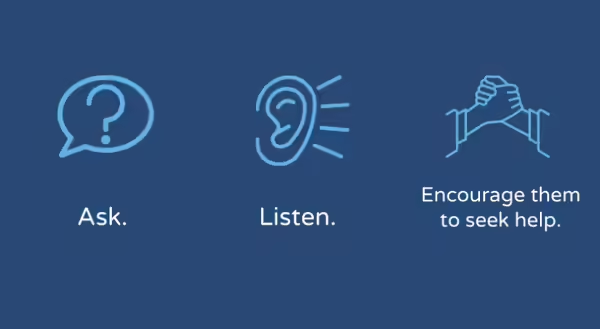
If you or someone you know is in an emergency, call The National Suicide Prevention Lifeline at 800-273-TALK (8255) or call 911 immediately.
September is National Suicide Prevention Month. To prevent suicide, we must be able to talk about it openly, which can sometimes be challenging. A national poll from the National Action Alliance for Suicide Prevention found that although 95% of people surveyed would take action if someone close to them was considering suicide, almost 70% said barriers such as not knowing what to say and not feeling comfortable with the topic kept them from discussing suicide with others.
However, being open to talking about suicide and making yourself aware of warning signs is more important now than ever. The American Academy of Pediatrics has shared emerging data that shows an increase in depression and suicidal concerns during the COVID pandemic for youth age 12 to 21.
How to talk to someone about suicide
- Look for signs and symptoms. Some people considering suicide will exhibit multiple signs, while others won’t exhibit any. It’s important to know the signs and symptoms of suicide and be on alert when talking to those around you.
- Ask them directly. If you suspect someone might be at risk of suicide, it’s important to directly ask about suicidal thoughts. Do not avoid using the word suicide. You can say things like, “Are you having thoughts of suicide?” or “Are you thinking about killing yourself?”
- Listen nonjudgmentally. If you believe the person is not in a crisis that needs immediate attention, you can engage them in conversation to see how they are feeling and how long they have been feeling this way. Listen in a kind and respectful way so the person feels comfortable to talk openly without being judged.
- Let the person know you are concerned and willing to help. Offer the person kindness and attention and let them know you are willing to help them find the support they need. Offer the person resources for professional help, such as through a community leader, therapist, physician, or family member. If you are concerned for the person’s immediate safety, call 911.
Source: The National Council for Mental Well-being, Mental Health First Aid curriculum
For more information on how to help someone who is suicidal, read this Mental Health First Aid Guide. You can also take a Mental Health First Aid course. The course will teach you how to identify, understand and respond to signs of suicide and depression. If you're interested in attending a Mental Health First Aid Training, visit www.mentalhealthfirstaid.org/take-a-course to sign up, and be on the lookout for our virtual Youth Mental Health First Aid (YMHFA) training on December 20, 2021. Email Emily Schoenfelder at Eschoe@illinois.edu for updates.
MEET THE AUTHOR
Judy Schmidt provides leadership to 4-H metro programming in Peoria County. Schmidt joined Extension in 2001, working as a Youth Development Educator at the East Peoria Center and joined the Fulton-Mason-Peoria-Tazewell unit in 2011. Her work focuses on 4-H youth development programming in the local metropolitan area, specifically leading positive youth development initiatives for after-school programs, community groups, 4-H clubs and other youth-serving organizations. Her areas of expertise include positive youth development principles, youth leadership, and work with teens as teachers.
Schmidt attended the University of Illinois at Urbana-Champaign for her bachelor's degree in psychology and also for her master's degrees in Social Work and Marriage and Family Therapy. She is a certified facilitator of the Matrixx System/Real Colors program by the National Curriculum and Training Institute.
ABOUT THE BLOG
Connection Corner is a blog that provides timely information, activities, and resources to help you stay connected to loved ones, the world around you, and yourself.